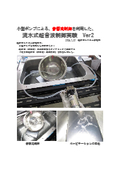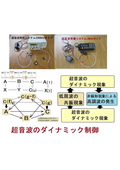Optimization techniques for the resonance phenomenon and nonlinear phenomena of ultrasonic cleaning machines—Analysis of ultrasonic sound pressure data: autocorrelation, bispectrum, power contribution rate, impulse response.
The Ultrasonic System Research Institute has developed a technology for ultrasonic <dynamic control> that optimizes the interaction of ultrasonic vibrations based on various analysis results of ultrasonic propagation states using an original ultrasonic system (sound pressure measurement analysis and oscillation control) and an abstract algebra model.
Note: The control of resonance phenomena (low harmonics) and nonlinear phenomena (high harmonics) is achieved by setting oscillation control conditions based on a logical model.
Compared to existing control technologies, this technique establishes and implements optimal control states tailored to the purposes of ultrasonic applications (cleaning, stirring, processing, etc.) through new measurement and evaluation parameters (note) related to the entire propagation path of ultrasonic vibrations, including various propagation tools.
This is a method and technology that can be applied immediately, and we offer it as consulting services (there is an increasing track record of precision cleaning and stirring at the nano level).
Note: Dynamic changes in the propagation state of tanks, transducers, target objects, and tools are measured, analyzed, and evaluated using original technology (ultrasonic testers).


Inquiry about this news
Contact Us Online
Related Documents
Related product
Related catalog(12)






























